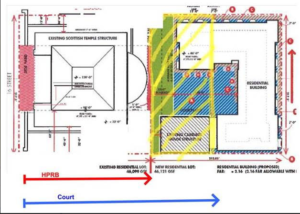Media Alert: Thursday, Nov. 3, 2022
Contact: Nick DelleDonne ,
delledonne.n@comcast.net, 703 929 6656
In Major Victory for DECAA Court Issues Injunction against City,
Agrees with DECAA on Boundaries of Masonic Temple Historic Landmark,
Rules City Violated DECAA’s Constitutional Right to Equal Protection of the Law
THE COURT’S ORDER:
“ORDERED that the Historical Preservation Review Board’s May 23, 2019, Decision in 16th Historic Landmark Case No. 19-06 pertaining to the Scottish-Rite Temple … is VACATED;
ORDERED that the District of Columbia, its officers, employees, and agents are ENJOINED from taking any action pursuant to the Historical Preservation Review Board’s May 23, 2019, Decision in Historic Landmark Case No. 19-06;
ORDERED that Declaratory Relief is entered clarifying that the boundary of the Scottish Rite Temple historic landmark as entered in the D.C. Inventory of Historic Sites, located at 1733 16th Street, Square 192, Lot 108, is equivalent to the boundary of Lot 820 as it existed in 1979”
BACKGROUND: Two years ago Dupont East Civic Action Association (DECAA) filed suit challenging the decision of the Historic Preservation Review Board (HPRB) to reduce the boundary of the Masonic Temple historic landmark site from more than 100 feet behind the Temple to less than 6 feet behind the Temple. HPRB did this so the developer, Perseus, could construct an oversized luxury apartment building on the site of the national historic landmark.
On Oct. 31, DECAA won a stunning victory in Court.
The Court invalidated HPRB’s decision and declared the boundary of the Temple landmark site runs from 16th St. to more than 100 feet behind the Temple.
Shown at the bottom of the attached diagram with a red arrow is the crimped area HPRB tried to say was the site of this historic landmark. The blue arrow at the bottom of the diagram shows the Court’s determination of the correct boundary of this national historic landmark (referred to by the Court as Lot 820). Marked in yellow on the diagram is what the Court determined is thus included in the footprint of this national historic landmark – more than 20,000 additional square feet of land.
Based on the Court’s determination the correct boundary lies through the middle of the luxury apartments and rooftop swimming pool and bar Perseus is presently constructing.
The Court’s injunction forbids DC and any of its officers and employees from relying in any way on HPRB’s vacated 2019 decision.
The Court in its decision castigated the DC government’s actions in this lawsuit as
“Defendants’ unrepentant, bad-faith conduct…
“an attempt to unfairly prejudice the Plaintiff or else remedy its own negligence.
“The Court is likewise disturbed by the District’s contention …
“Setting aside the District’s insinuation that it failed its duty to respond to discovery in good faith
“District’s contumacious conduct…”
With respect to HPRB the Court held:
“The challenge, however, is that the HPRB commandeered Plaintiffs’ application to expand the boundary and warped it into a decision about reducing the boundaries.”
“[T]he District has not identified any instance where it decided to … reduce an historical landmark’s boundary in response to an application to expand the boundary.”
“Therefore, as a matter of law, the Court must hold that the District treated Plaintiffs’ application differently from any other application without a rational basis for doing so.”
The Court then held that the District government denied Plaintiffs their Constitutional right to Equal Protection under law.
On remand to HPRB
“Now that there is clarity that the boundary of the Temple landmark lies along the boundary line of the former Lot 820, the HPRB can consider the actual question presented: should the Temple landmark boundary be expanded to include all of Lot 108? On remand, the HPRB shall not be free take any action except to grant Plaintiffs’ application, deny it, or expand the boundary in part.”
The Court ordered that Plaintiffs “shall be entitled to reasonable attorney fees and costs incurred in this matter” from the DC government.
DECAA was represented by attorneys Barry Coburn https://www.coburnandgreenbaum.com/barry-coburn and Marc Eisenstein https://www.coburnandgreenbaum.com/marc-e of the law firm of Coburn and Greenbaum, PLLC, who dedicated many hours pro bono to a small civic organization. DECAA was represented also by DECAA Board Member and former Assistant US Attorney Michael Hays.
“This unambiguous decision should be a signal to city leadership to respect its lawful obligation for historic preservation, not to commercial interests, but to the community it serves,” DECAA president Nick DelleDonne said.
Attachments: Diagram of Masonic lots, Court decision
![]()
